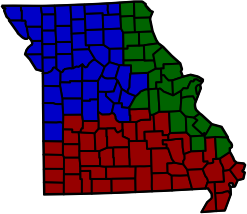Judges
The Seventh District Court of Appeals is composed of four judges, each elected to six-year terms by the citizens of the eight counties in the district. [3] Ohio Law requires that a person running for election as an appellate judge must have been licensed as an attorney in Ohio for at least six years or have served as a judge in any jurisdiction for at least six years. [4] The current judges of the court (as of October 2022) are: [1]
| Judge (party) | Joined Court | Term ends |
|---|
| February 9, 1993 | February 8, 2023 |
Cheryl L. Waite (D) | February 10, 1997 | February 9, 2027 |
| February 9, 2015 | February 8, 2027 |
| February 9, 2019 | February 8, 2025 |
Attorney Mark A. Hanni (R) was elected on November 8, 2022, defeating Gene Donofrio (D). He will take office on February 9, 2023.
Each case on appeal is decided by a panel of three judges. [5] Cases are decided through a review of the record of the inferior court or tribunal, as informed by the briefs submitted by the parties and by oral argument (if requested by either party). New evidence is not permitted to be introduced on appeal.

The United States district courts are the trial courts of the U.S. federal judiciary. There is one district court for each federal judicial district, which each cover one U.S. state or, in some cases, a portion of a state. Each district court has at least one courthouse, and many districts have more than one. District courts' decisions are appealed to the U.S. court of appeals for the circuit in which they reside, except for certain specialized cases that are appealed to the U.S. Court of Appeals for the Federal Circuit or directly to the U.S. Supreme Court.

In the United States, a district attorney (DA), county attorney, state's attorney, prosecuting attorney,commonwealth's attorney, or state attorney is the chief prosecutor and/or chief law enforcement officer representing a U.S. state in a local government area, typically a county or a group of counties. The exact name and scope of the office varies by state. Alternative titles for the office include county attorney, solicitor, or county prosecutor.

The government of Maryland is conducted according to the Maryland Constitution. The United States is a federation; consequently, the government of Maryland, like the other 49 state governments, has exclusive authority over matters that lie entirely within the state's borders, except as limited by the Constitution of the United States.

The U.S. District Court for the Northern District of Ohio is the federal trial court for the northern half of Ohio–essentially everything north of the Columbus area. The court has courthouses in Cleveland, Toledo, Akron and Youngstown.

The United States District Court for the Southern District of Ohio is one of two United States district courts in Ohio and includes forty-eight of the state's eighty-eight counties–everything from the Columbus area southward. Appeals from the court are taken to the United States Court of Appeals for the Sixth Circuit at Cincinnati.

The United States District Court for the Eastern District of Michigan is the federal district court with jurisdiction over of the eastern half of the Lower Peninsula of the State of Michigan. The Court is based in Detroit, with courthouses also located in Ann Arbor, Bay City, Flint, and Port Huron. The United States Court of Appeals for the Sixth Circuit has appellate jurisdiction over the court.

The United States District Court for the Western District of Michigan is the federal district court with jurisdiction over of the western portion of the state of Michigan, including the entire Upper Peninsula and the Lower Peninsula from Lansing westward.
The structure of the judiciary of Texas is laid out in Article 5 of the Constitution of Texas and is further defined by statute, in particular the Texas Government Code and Texas Probate Code. The structure is complex, featuring many layers of courts, numerous instances of overlapping jurisdiction, several differences between counties, as well as an unusual bifurcated appellate system at the top level found in only one other state: Oklahoma. Municipal Courts are the most active courts, with County Courts and District Courts handling most other cases and often sharing the same courthouse.

The California Courts of Appeal are the state intermediate appellate courts in the U.S. state of California. The state is geographically divided along county lines into six appellate districts. The Courts of Appeal form the largest state-level intermediate appellate court system in the United States, with 106 justices.
The Ohio District Courts of Appeals are the intermediate appellate courts of the U.S. state of Ohio. The Ohio Constitution provides for courts of appeals that have jurisdiction to review final appealable orders. There are twelve appellate districts, each consisting of at least one county, and the number of judges in each district varies from four to twelve. Each case is heard by a three-judge panel. There are currently 69 courts of appeals judges as provided by statute. A court of appeals judge is an elected position, with a term of six years. The Ohio Supreme Court has the discretion to review cases from the courts of appeals, but generally the appeals process in Ohio ends with the decision of the court of appeals.

Superior courts in California are the state trial courts with general jurisdiction to hear and decide any civil or criminal action which is not specially designated to be heard in some other court or before a governmental agency. As mandated by the California Constitution, there is a superior court in each of the 58 counties in California. The superior courts also have appellate divisions which hear appeals from decisions in cases previously heard by inferior courts.

The United States District Court for the Eastern District of Kentucky is the Federal district court whose jurisdiction comprises approximately the Eastern half of the Commonwealth of Kentucky. The United States Court of Appeals for the Sixth Circuit in Cincinnati, Ohio maintains appellate jurisdiction for the district.

The United States District Court for the Western District of Kentucky is the federal district court for the western part of the state of Kentucky.
The Ohio Eleventh District Court of Appeals is one of twelve appellate courts in Ohio. It is a state court. The Eleventh District is composed of five counties: Ashtabula, Geauga, Lake, Portage, and Trumbull.

The Missouri Court of Appeals is the intermediate appellate court for the state of Missouri. The court handles most of the appeals from the Missouri Circuit Courts. The court is divided into three geographic districts: Eastern, Western, and Southern. For example, appeals taken from trials in St. Louis County will go to the Eastern District, and appeals taken from trials in Jackson County will go to the Western District.
The Government of Guam (GovGuam) is a presidential representative democratic system, whereby the President is the head of state and the Governor is head of government, and of a multi-party system. Guam is an organized, unincorporated territory of the United States with policy relations between Guam and the US under the jurisdiction of the Office of Insular Affairs.
The Judiciary of Vermont is the state court system of Vermont, charged with Vermont law.
The West Virginia Circuit Courts are the West Virginia state trial courts of general jurisdiction. They are the only state trial courts in West Virginia that are courts of record. West Virginia's 55 counties are divided into 31 circuits, each comprising anywhere from one to four counties. Different circuits have different numbers of judges; 11 circuits have only a single judge.

The Judiciary of California or the Judicial Branch of California is defined under the California Constitution as holding the judicial power of the state of California which is vested in the Supreme Court, the Courts of Appeal and the Superior Courts. The judiciary has a hierarchical structure with the California Supreme Court at the top, California Courts of Appeal as the primary appellate courts, and the California Superior Courts as the primary trial courts.
The Judiciary of Virginia is defined under the Constitution and law of Virginia and is composed of the Supreme Court of Virginia and subordinate courts, including the Court of Appeals, the Circuit Courts, and the General District Courts. Its administration is headed by the Chief Justice of the Supreme Court, the Judicial Council, the Committee on District Courts, the Judicial Conferences, the Judicial Inquiry and Review Commission, and various other offices and officers.













